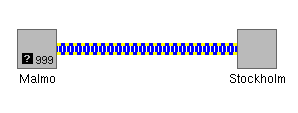By default, the representation of the base
of a link is determined by its base style, which is itself
calculated from the state of the link.
How to change the graphical representation of a link (using CSS)
You might want to define specific link representations,
regardless of the base styles managed by JViews TGO (when you do
not use states, for example). In this case, you can change the
representation of the link using cascading style sheets.
The following example shows an extract of a CSS file which
changes the representation of a given link. Note that to make
this possible, you must use the object state IltAlarmObjectState, IltTrapObjectState, or no object state at
all for this specific link, since using another state system
would force the appearance of the link base.
#myLink {
centerWidth: 6;
foreground: blue;
background: '';
lineStyle: "3.000001, 1.000001";
borderWidth: 3;
borderColor: yellow;
borderColor2: blue;
reliefBorders: false;
borderLineStyle: Dot;
}
For details on how to load a configuration like this one in a
network component, see How to load a CSS file in a network
component.
The link is represented as a hatched
central line with a blue background color and two identical
border lines hatched in yellow on a transparent background, as
shown below:

Customizing a link representation
Changing the representation of links based on states and llarms
For details about how to customize the links that are based on
object and alarm states, refer to Customizing the object representation based
on states.
Customizing link states and alarms
For information on how to customize the link representation when
it contains states and alarms, refer to Customizing object and alarm states of
predefined business objects. The information that you will find
in that section is valid for all
IltObject
classes.